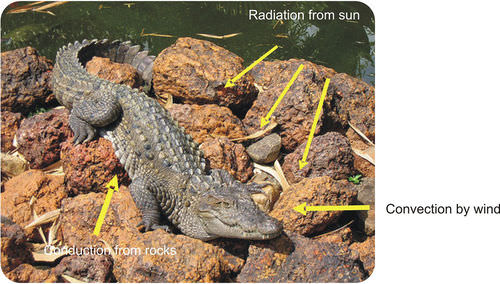12.14 恢复结构和功能
章节大纲
-
Why did amphibians evolve into reptiles?
::为什么两栖动物会演变成爬行动物?It probably has to do with food and land. Having to live close to limits the resources available to a . Having the ability to live away from water allowed to search for additional food.
::它可能与食物和土地有关,必须靠靠近生活来限制提供给一个人的资源。 能够远离水生活,可以去寻找更多的食物。Structure and Function in Reptiles
::安置的结构和职能Reptiles are a class of tetrapod vertebrates that produce amniotic eggs . They include crocodiles, alligators, lizards, snakes, and . The reptile class is one of the largest classes of vertebrates. It consists of all amniotes except and mammals . Reptiles have several adaptations for living on dry land that lack. For example, as shown in Figure , the skin of most reptiles is covered with scales. The scales, which are made of very tough keratin , protect reptiles from injury and prevent them from losing water.
::爬虫类是产生羊蛋的四面脊椎动物,包括鳄鱼、鳄鱼、蜥蜴、蛇和。爬虫类是最大的脊椎动物类别之一。它包括除哺乳动物以外的所有动物和哺乳动物。爬虫类有几种适应性适应性,以适应生活在缺水的旱地。例如,如图所示,大多数爬虫动物的皮肤覆盖在尺度上。这些尺度由非常坚硬的氯丁二烯制成,保护爬行动物免受伤害,防止它们失去水。Crocodile Scales. These crocodiles are covered with tough, waterproof scales.
::这些鳄鱼被坚固、防水的鳄鱼覆盖Reptile Respiration
::弹性呼吸The scales of reptiles prevent them from absorbing oxygen through their skin, as amphibians can. Instead, reptiles breathe air only through their lungs . However, their lungs are more efficient than the lungs of amphibians, with more surface area for gas exchange. This is another important reptile adaptation for life on land.
::爬虫类的大小阻止了它们通过皮肤吸收氧气,正如两栖动物可以做的那样。相反,爬虫类只能通过肺呼吸空气。然而,它们的肺比两栖动物的肺更高效,更多的表面积用于气体交换。 这是陆地上生命的另一个重要的爬虫类适应性。Reptiles have various ways of moving air into and out of their lungs. use of the chest wall for this purpose. These are the same muscles used for running, so lizards have to hold their breath when they run. Crocodiles and alligators have a large sheet of muscle below the lungs, called a diaphragm , that controls their . This is a structure that is also found in mammals.
::爬虫类有不同的方式将空气流进和流出其肺部。 使用胸壁来做此用途。 这些肌肉是用来运行的, 所以蜥蜴在运行时必须屏住呼吸。 鳄鱼和鳄鱼的肺下有大量肌肉, 叫做隔膜, 控制它们。 这是哺乳动物中也发现了的结构 。Ectothermy in Reptiles
::爬行动物的取温Like amphibians, reptiles are ectotherms with a slow metabolic rate. Their metabolism doesn’t generate enough energy to keep their body temperature stable. Instead, reptiles regulate their body temperature through their behavior. For example, the crocodile in Figure is soaking up heat from the environment by basking in the sun. Because of their ectothermy , reptiles can get by with as little as one tenth the food needed by endotherms such as mammals. Some species of reptiles can go several weeks between meals.
::和两栖动物一样,爬行动物是代谢率缓慢的切除物。 它们的新陈代谢并没有产生足够的能量来保持身体温度稳定。 相反,爬行动物通过行为调节体温。 比如,图中的鳄鱼正在通过在太阳中烘烤而从环境中吸收热量。 爬行动物的切除作用是能够克服的,只有哺乳动物等外科动物所需要的食物的十分之一。 一些爬行动物的种类可以在两餐之间间隔数周。Heat Transfer to an Ectothermic Reptile. This crocodile is being warmed by the environment in three ways. Heat is radiating directly from the sun to the animal’s back. Heat is also being conducted to the animal from the rocks it rests on. In addition, convection currents are carrying warm air from surrounding rocks to the animal’s body.
::热向热向温室转移。 这只鳄鱼以三种方式被环境温暖。 热从太阳直接照射到动物的背部。 热也从动物的岩石向动物进行热。 此外,对流水流从周围的岩石向动物的身体输送温暖空气。Other Reptile Structures
::其他安置结构Like amphibians, most reptiles have a heart with three chambers, although crocodiles and alligators have a four-chambered heart like birds and mammals. The reptile brain is also similar in size to the amphibian brain, taking into account overall body size. However, the parts of the reptile brain that control the and are larger than in amphibians.
::像两栖动物一样,大多数爬行动物的心脏有三个孔,尽管鳄鱼和鳄鱼的心脏与鸟类和哺乳动物一样有四组的心脏。 爬行动物的大脑大小也与两栖大脑相似,考虑到整个身体大小。 然而,控制着爬行动物的大脑部分比两栖动物大。Most reptiles have good eyesight and a keen sense of smell . Snakes smell scents in the air using their forked tongue (see Figure ). This helps them locate prey . Some snakes have heat-sensing organs on their head that help them find endothermic prey, such as small mammals and birds.
::大多数爬行动物有良好的视力和敏锐的嗅觉。蛇用其叉舌闻到空气中的气味(见图 ) 。 这有助于它们找到猎物。 有些蛇头上有热感应器官,帮助它们找到小哺乳动物和鸟类等热性猎物。Snake “Smelling” the Air. A snake flicks its tongue in and out to capture scent molecules in the air.
::蛇在空气中“熔化”蛇,蛇的舌头在空气中闪烁,以捕捉气味分子。Summary
::摘要-
Reptiles are a class of ectothermic, tetrapod vertebrates.
::爬行动物是一类异热类 四肢脊椎动物 -
Reptiles have several adaptations for living on dry land, such as tough keratin scales and efficient lungs for breathing air.
::爬虫类有几种适应旱地生活的适应方法,例如坚硬的氯丁二烯比例尺和呼吸空气的高效肺。 -
Reptiles have a three-chambered heart and relatively well-developed brain.
::爬虫类有三组人的心脏 和相对发达的大脑。
Review
::回顾-
Describe reptile scales and the functions they serve.
::描述爬行动物比例尺及其所起作用的功能。 -
What is a diaphragm? What does it do?
::隔膜是什么? -
Describe two senses that snakes may use to locate prey.
::描述蛇可能用来定位猎物的两种感官 -
Pretend you are a reptile such as a lizard. Explain how you might stay warm on a cold day.
::假装你像蜥蜴一样爬行动物 解释你如何在寒冷的一天保持温暖
-
Reptiles are a class of ectothermic, tetrapod vertebrates.



